engine overheat BUICK CENTURY 1994 Owners Manual
[x] Cancel search | Manufacturer: BUICK, Model Year: 1994, Model line: CENTURY, Model: BUICK CENTURY 1994Pages: 308, PDF Size: 16.3 MB
Page 11 of 308
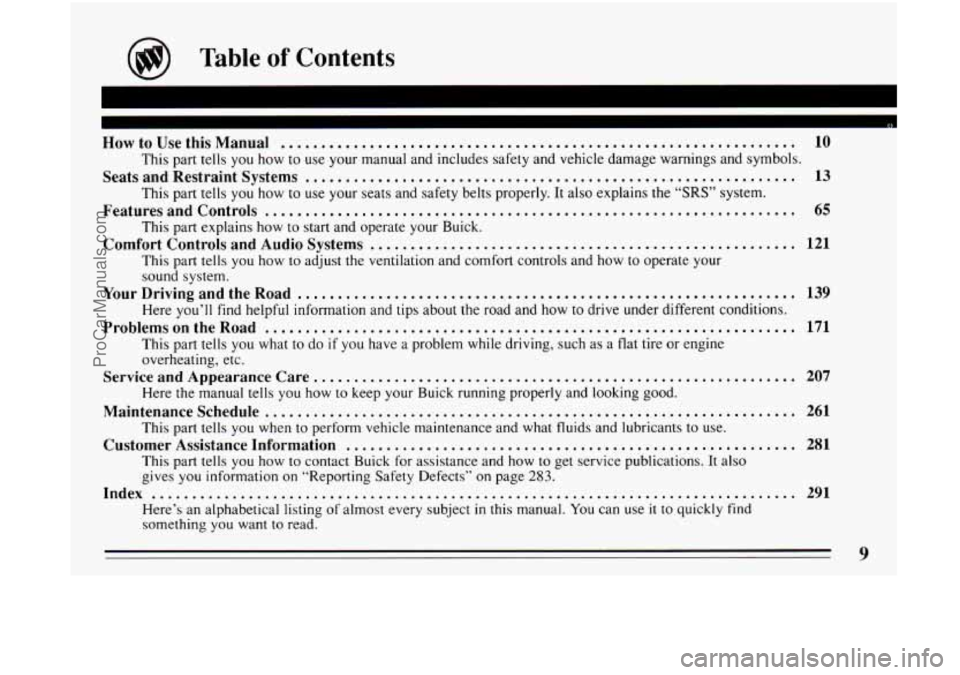
@ Table of Contents
How to Use this Manual ................................................................ 10
This part tells you how to use your manual and includes safet\
y and vehicle damage warnings and symbols.
Seats and Restraint Systems ............................................................. 13
This part tells you how to use your seats and safety belts p\
roperly. It also explains the “SRS” system.
This part explains how
to start and operate your Buick.
This part tells you how to adjust the ventilation and comfort \
controls and how to operate your sound system.
YourDrivingandtheRoad .............................................................. 139
Here you’ll find helpful information and tips about the road\
and how to drive under different conditions.
ProblemsontheRoad .................................................................. 171
This part tells you what to do if you have a problem while driving, such as a flat tire or engine
overheating, etc.
Here the manual tells you how to keep your Buick running prop\
erly and looking good.
This part tells you when to perform vehicle maintenance and wh\
at fluids and lubricants to use.
This part tells you how to contact Buick for assistance and h\
ow
to get service publications. It also
gives
you information on “Reporting Safety Defects” on page 283.
Here’s an alphabetical listing of almost every subject in this manual. You can use it to quickly find
something
you want to read.
FeaturesandControls .................................................................. 65
Comfort Controls and Audio Systems ..................................................... 121
ServiceandAppearanceCare ............................................................ 207
Maintenanceschedule .................................................................. 261
Customer Assistance Information
........................................................ 281
Index
........................................................................\
........ 291
7
ProCarManuals.com
Page 117 of 308
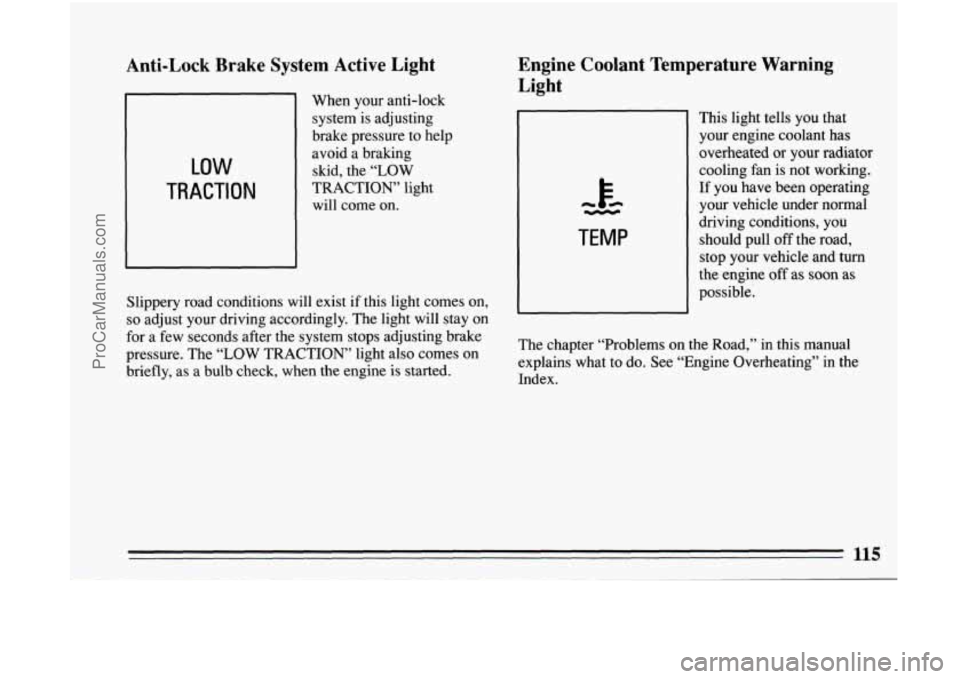
Anti-Lock Brake System Active Light
LOW
TRACTION
When your anti-lock
system is adjusting
brake pressure to help
avoid a braking
skid, the
“LOW
TRACTION’ light
will come on.
Slippery road conditions will exist if this light comes on,
so adjust your driving accordingly. The light will stay on
for
a few seconds after the system stops adjusting brake
pressure. The
“LOW TRACTION” light also comes on
briefly, as a
bulb check, when the engine is started.
Engine Coolant Temperature Warning
Light
k F- 4ccN
TEMP
This light tells you that
your engine coolant has
overheated or your radiator
cooling fan is not working.
If you have been operating
your vehicle under normal
driving conditions, you
should pull off the road,
stop your vehicle and turn
the engine
off as soon as
possible.
The chapter “Problems on the Road,” in this manual
explains what to do. See “Engine Overheating” in the
Index.
ProCarManuals.com
Page 118 of 308
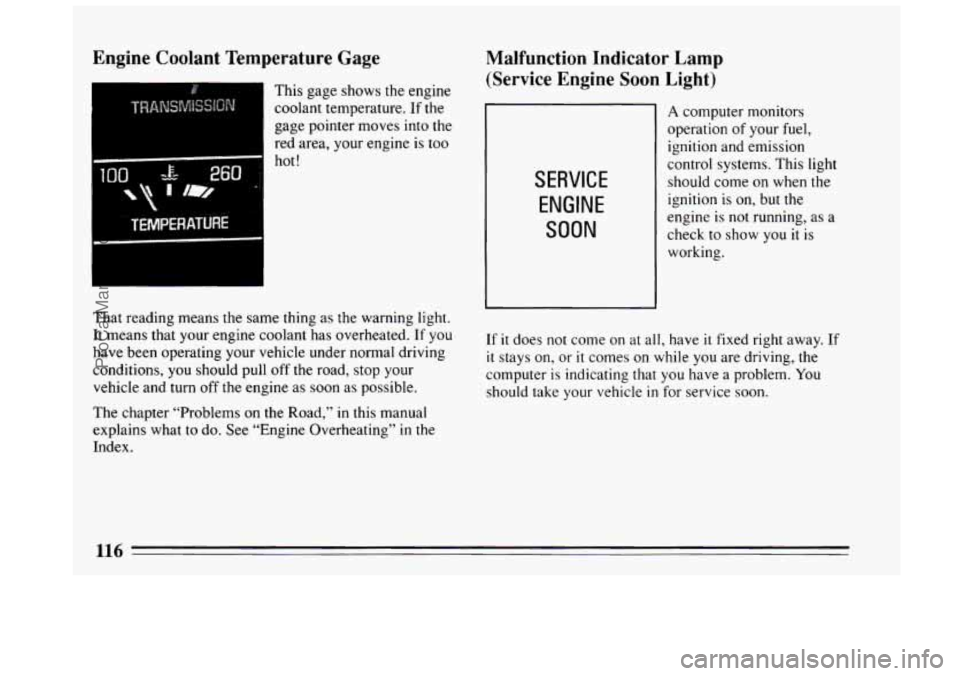
Engine Coolant Temperature Gage
This gage shows the engine
coolant temperature. If the
gage pointer moves into the
red area, your engine is too
100 -E- 260 i
T lm,
hot!
TEMPERATURE
That reading means the same thing as the warning light.
It means that your engine coolant has overheated. If you
have been operating your vehicle under normal driving
conditions, you should pull off the road, stop your
vehicle and
turn off the engine as soon as possible.
The chapter “Problems on the Road,”
in this manual
explains what
to do. See “Engine Overheating” in the
Index.
Malfunction Indicator Lamp
(Service Engine Soon Light)
SERVICE
ENGINE
SOON
A computer monitors
operation of your fuel,
ignition and emission
control systems. This light
should come on when the
ignition is on, but the
engine is not running, as
a
check to show you it is
working.
If it does not come on at all, have it fixed right away. If
it stays on, or it comes on while you are driving, the
computer is indicating that
you have a problem. You
should take your vehicle
in for service soon.
116
ProCarManuals.com
Page 171 of 308
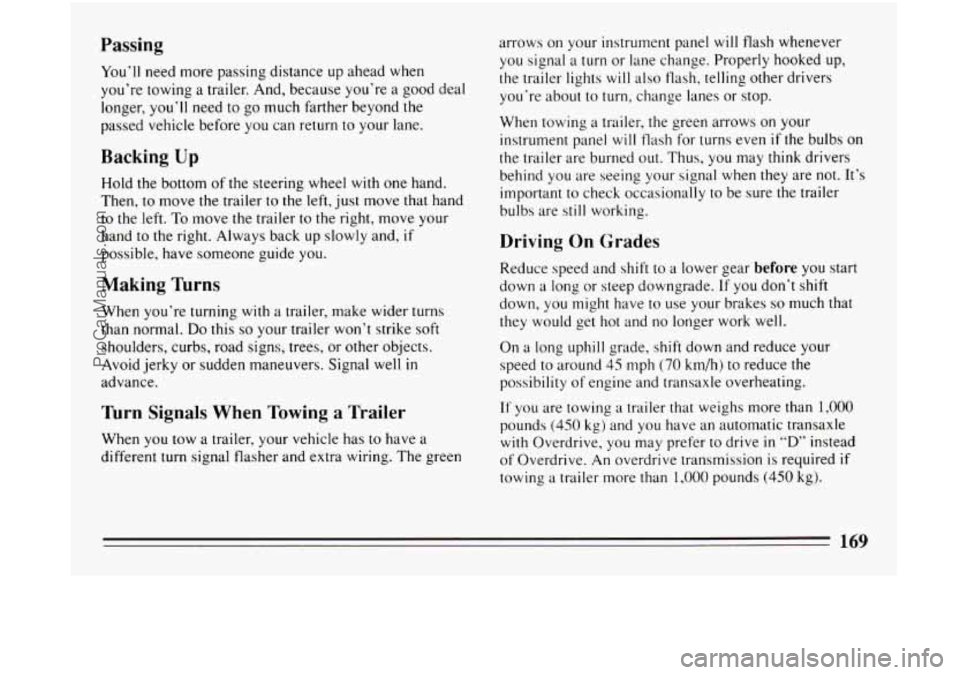
Passing
You’ll need more passing distance up ahead when
you’re towing a trailer. And, because you’re a good deal
longer, you’ll need to go much farther beyond the
passed vehicle before you can return to
your lane.
Backing Up
Hold the bottom of the steering wheel with one hand.
Then, to move the trailer to the left, just move that hand
to the left.
To move the trailer to the right, move your
hand to the right. Always back up slowly and,
if
possible, have someone guide you.
Making Turns
When you’re turning with a trailer, make wider turns
than normal.
Do this so your trailer won’t strike soft
shoulders, curbs, road signs, trees, or other objects.
Avoid jerky
or sudden maneuvers. Signal well in
advance.
Turn Signals When Towing a Trailer
When you tow a trailer, your vehicle has to have a
different turn signal flasher and extra wiring. The green arrows
on your instrument panel
will flash whenever
you signal
a turn or lane change. Properly hooked up,
the trailer lights
will also flash, telling other drivers
you’re about to turn, change lanes or stop.
When towing a trailer, the green arrows on your
instrument panel
will flash for turns even if the bulbs on
the trailer are burned out. Thus, you may
think drivers
behind you are seeing your signal when they are not. It’s
important to check occasionally to be sure
the trailer
bulbs are still working.
Driving On Grades
Reduce speed and shift to a lower gear before you start
down a long or steep downgrade.
If you don’t shift
down, you might have
to use your brakes so much that
they would get hot and no longer work well.
On a long
uphill grade, shift down and reduce your
speed to around 45
mph (70 km/h) to reduce the
possibility
of engine and transaxle overheating.
If you are towing a trailer that weighs more than 1,000
pounds (450
kg) and you have an automatic transaxle
with Overdrive, you may prefer to drive in “D” instead
of Overdrive.
An overdrive transmission is required if
towing a trailer more than 1,000 pounds (450 kg).
ProCarManuals.com
Page 173 of 308
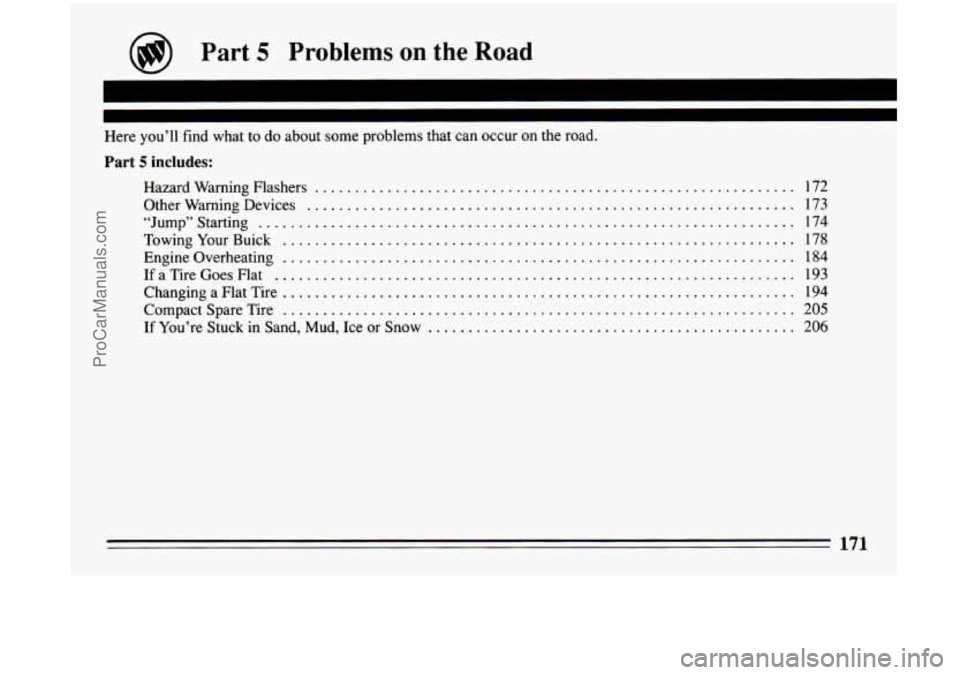
@) Part 5 Problems on the Road
I
I
Here you’ll find what to do about some problems that can occur on the road .
Part 5 includes:
HazardWarningFlashers ............................................................ 172
OtherWarningDevices
............................................................. 173
“Jump”Starting
................................................................... 174
TowingYourBuick
................................................................ 178
Engineoverheating
................................................................ 184
IfaTireGoesFlat
................................................................. 193
ChangingaFlatTire
................................................................ 194
CompactSpareTire
................................................................ 205
If You’re Stuck in Sand, Mud, Ice or Snow .............................................. 206
1 I1
ProCarManuals.com
Page 186 of 308
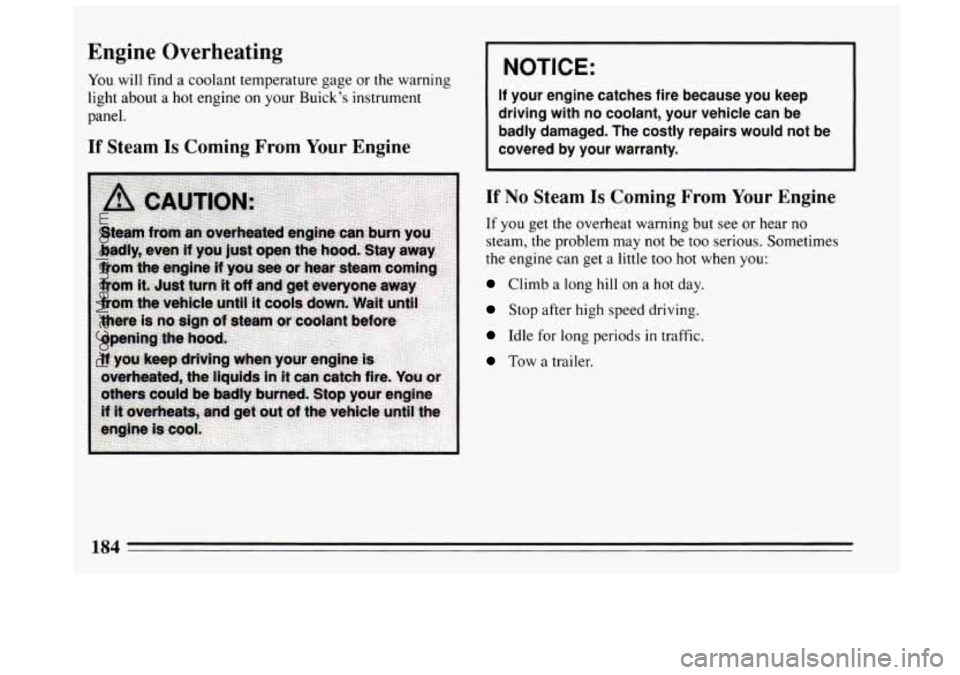
Engine Overheating
You will find a coolant temperature gage or the warning
light about a hot engine on
your Buick’s instrument
panel.
If Steam Is Coming From Your Engine
I NOTICE:
If your engine catches fire because you keep
driving with no coolant, your vehicle can be
badly damaged. The costly repairs would not be
covered by your warranty.
If No Steam Is Coming From Your Engine
If you get the overheat warning but see or hear no
steam, the problem may not be too serious. Sometimes
the engine can get a little too hot when
you:
Climb a long hill on a hot day.
Stop after high speed driving.
Idle for long periods in traffic.
Tow a trailer.
184
ProCarManuals.com
Page 187 of 308
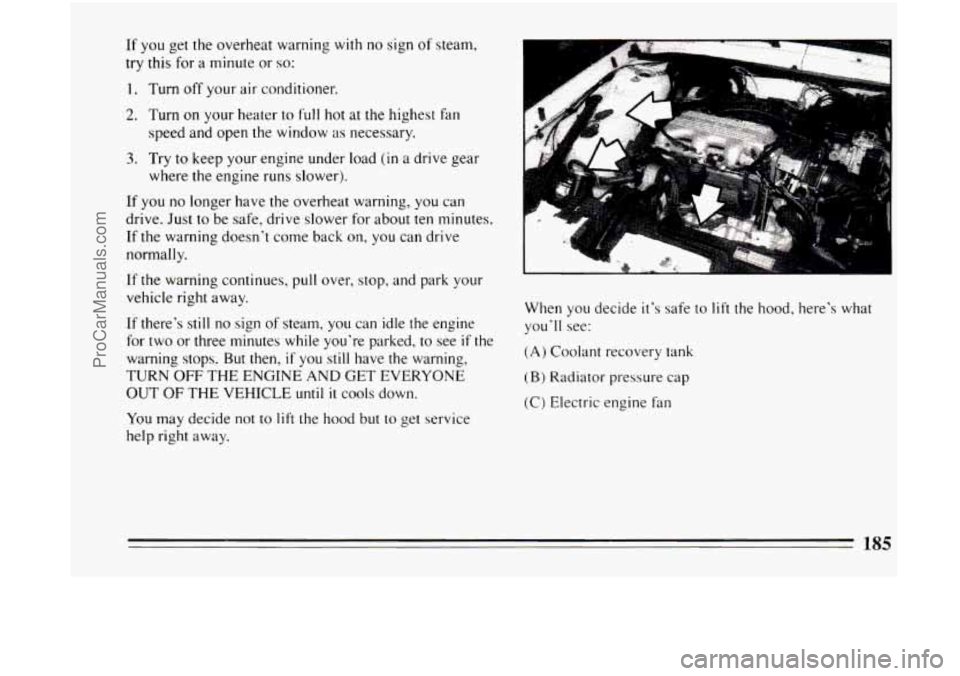
If you get the overheat warning with no sign of steam,
try this for a minute or
so:
1. Turn off your air conditioner.
2. Turn on your heater to full hot at the highest fan
speed and open the window as necessary.
3. Try to keep your engine under load (in a drive gear
where the engine runs slower).
If you no longer have the overheat warning, you can
drive. Just to be safe, drive slower for about ten minutes.
If the warning doesn't come back on, you can drive
normally.
If the warning continues, pull over, stop, and park your
vehicle right away.
If there's still no sign of steam, you can idle the engine
for two or three minutes while you're parked, to see
if the
warning stops.
But then, if you still have the warning,
TURN OFF THE ENGINE AND GET EVERYONE
OUT OF THE VEHICLE until it cools down. When you
decide it's safe to
lift the hood, here's what
you'll see:
(A) Coolant recovery tank
(B) Radiator pressure cap
(C) Electric engine fan
You may decide not to
lift the hood but to get service
help right away.
185
ProCarManuals.com
Page 189 of 308
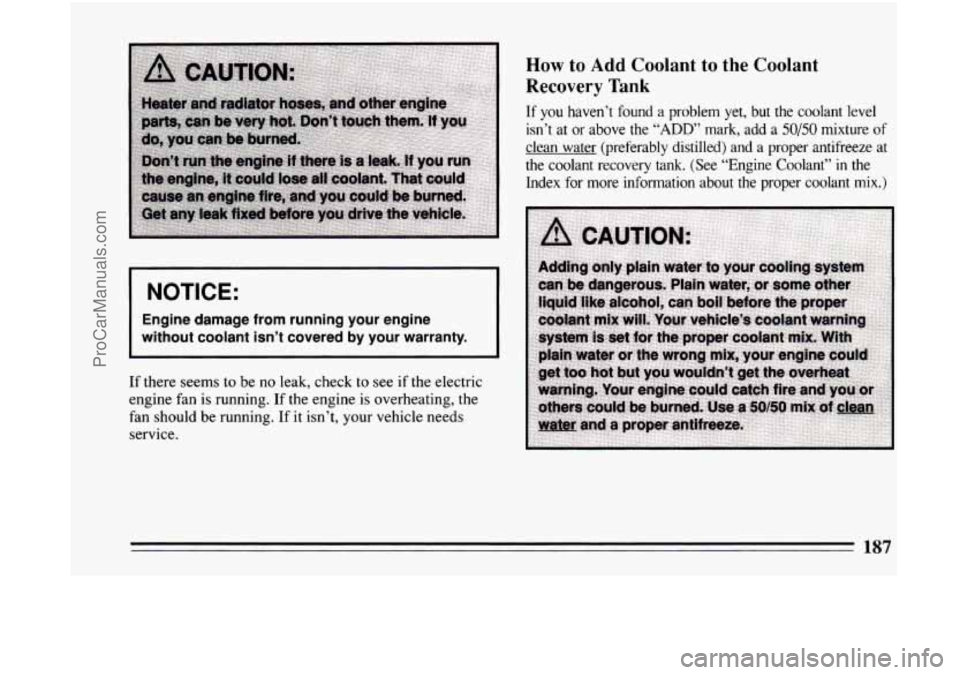
1 NOTICE: I
I
Engine damage from running your engine
without coolant isn’t covered by your warranty.
If there seems to be no leak, check to see if the electric
engine fan is running. If the engine
is overheating, the
fan should be running. If
it isn’t, your vehicle needs
service.
How to Add Coolant to the Coolant
Recovery Tank
If you haven’t found a problem yet, but the coolant level
isn’t at or above the
“ADD” mark, add a 50/50 mixture of
clean water (preferably distilled) and a proper antifreeze at \
the coolant recovery
tank. (See “Engine Coolant” in the
Index for more information about the proper coolant mix.)
187
ProCarManuals.com
Page 190 of 308
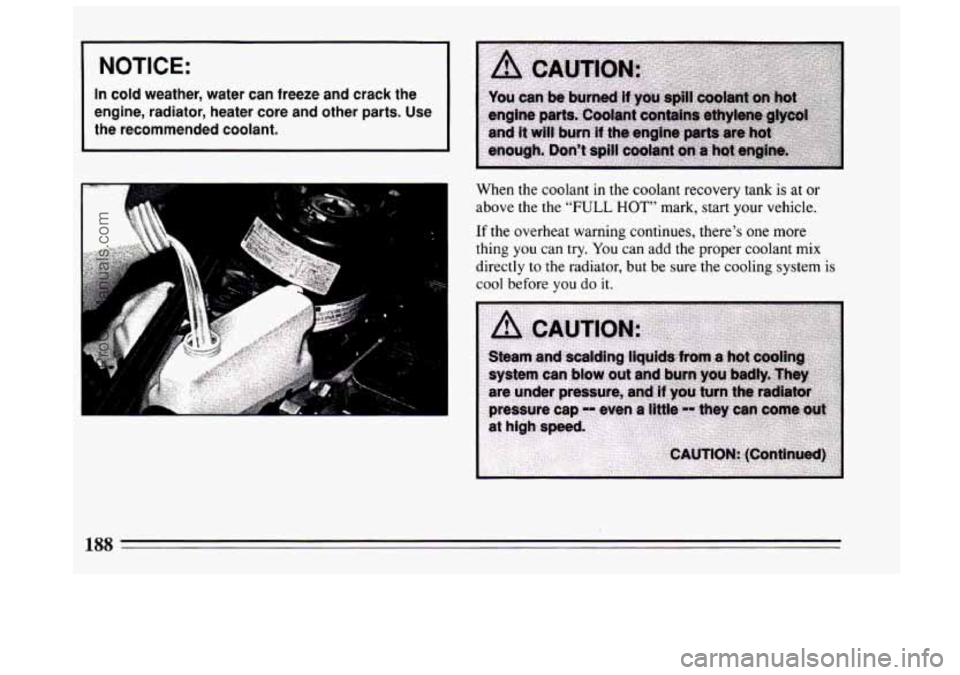
NOTICE:
In cold weather, water can freeze and crack the
engine, radiator, heater core
and other parts. Use
the recommended coolant.
When the coolant in the coolant recovery tank is at or
above the the
“FULL HOT” mark, start your vehicle.
If the overheat warning continues, there’s one more
thing
you can try. You can add the proper coolant mix
directly to the radiator, but be sure the cooling system is
cool before you
do it.
188
ProCarManuals.com
Page 191 of 308
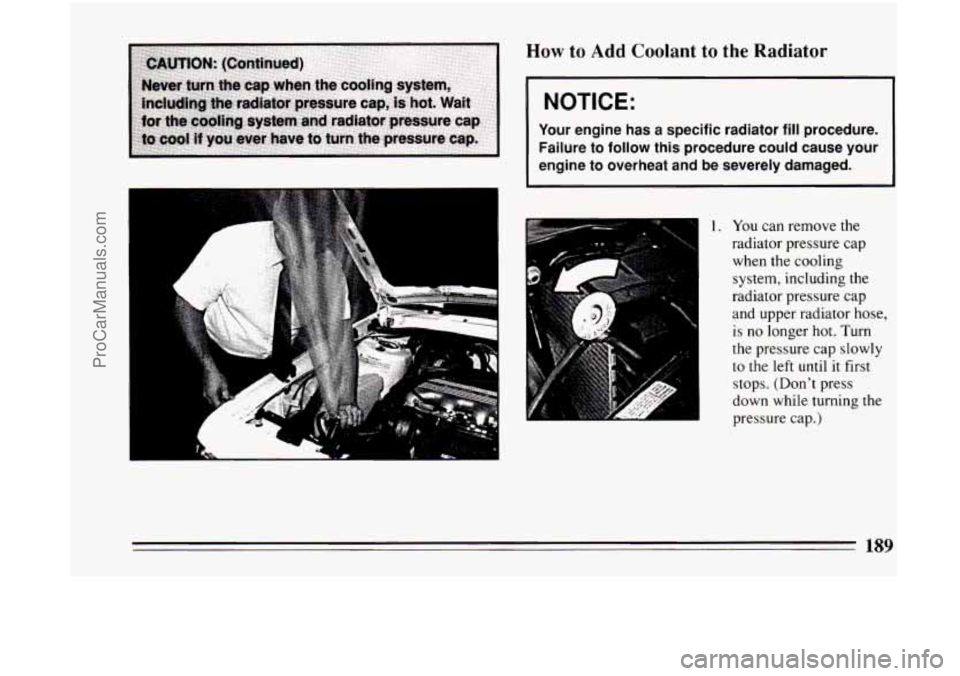
How to Add Coolant to the Radiator
NOTICE:
Your engine has a specific radiator fill procedure.
Failure
to follow this procedure could cause your
engine
to overheat and be severely damaged.
1. You can remove the
1 radiator pressure cap
when the cooling
system, including the
radiator pressure cap
and upper radiator hose,
is no longer hot. Turn
the pressure cap slowly
to the left until it first
stops. (Don't press
down while turning the
pressure cap.)
189
ProCarManuals.com